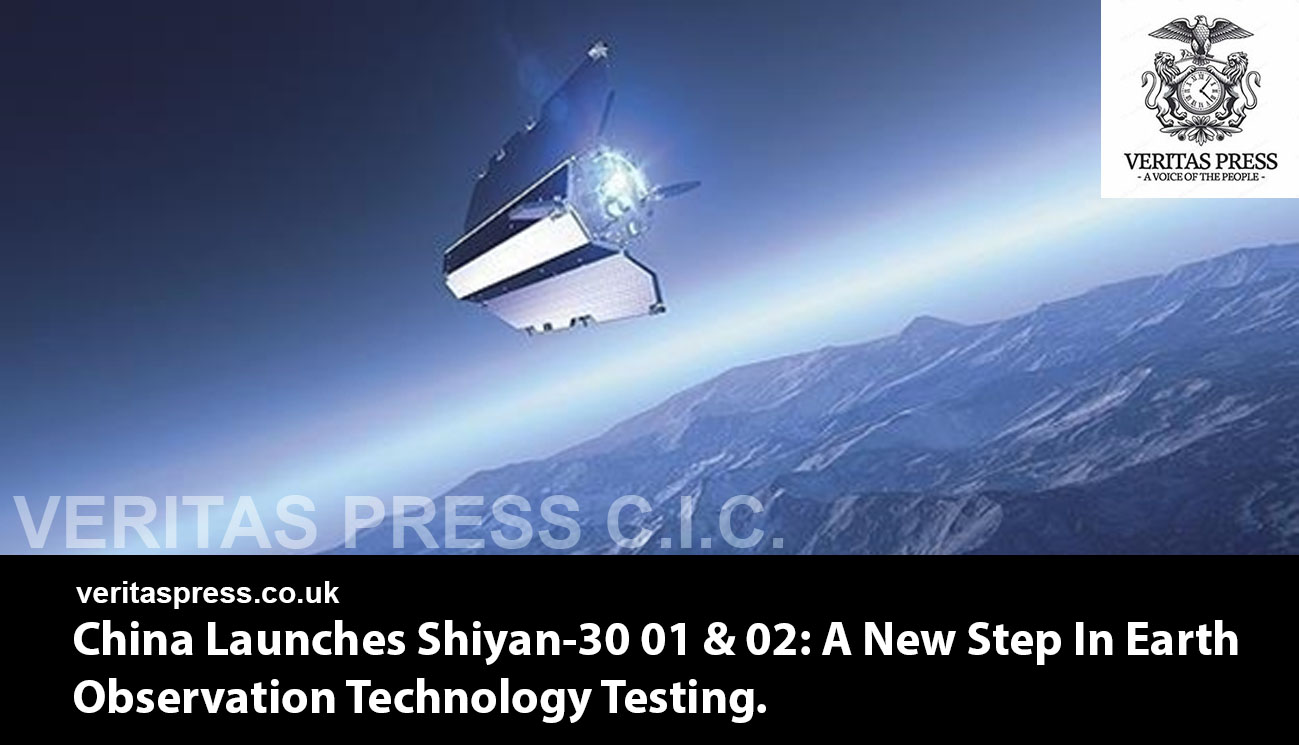Press Release: Veritas Press C.I.C.
Author: Kamran Faqir
Article Date Published: 01 Oct 2025 at 19:15 GMT
Category: Asia | China | China Launches Shiyan-30 01 & 02
Source(s): Veritas Press C.I.C. | Multi News Agencies
Business Ads


On September 29, 2025, China successfully launched two test satellites, Shiyan-30 01 and 02, from the Xichang Satellite Launch Centre in Sichuan province. Lift-off occurred at 11:00 a.m. Beijing time (03:00 GMT) aboard a Long March-2D (CZ-2D) carrier rocket, and the satellites entered their designated orbits as planned, state media reported.
Mission Purpose And Significance:
The primary mission for Shiyan-30 01 and 02 is the experimental verification of Earth observation technologies. As testbed or “technology demonstration” satellites, they are not intended immediately for full operational service, but rather to validate new sensors, imaging techniques, data processing pipelines, and related subsystems under real orbital conditions.
“Shiyan” literally means “experiment” in Chinese, and past missions in the Shiyan series have played roles in testing remote sensing, communications, navigation, and other space technologies. The Shiyan line often straddles both civilian and strategic interests, enabling China to push forward dual-use capabilities.
In the broader context, this launch aligns with China’s long-term strategy to strengthen its Earth observation infrastructure, both for environmental monitoring, disaster response, land use mapping, agricultural management, and strategic reconnaissance.
The Rocket: Long March-2D Enters A Milestone.
This launch also marked a number of symbolic milestones:
- It was the 598th flight mission in the overall Long March family of carrier rockets.
- It was the 100th flight of the Long March-2D variant.
- The Long March-2D is a two-stage, liquid-fueled launch vehicle, historically used for placing satellites into low-Earth and sun-synchronous orbits.
- According to official sources, the Long March-2D has delivered over 300 satellites into orbit over its lifespan, including remote sensing, scientific, mapping, and experimental spacecraft.
- The rocket has also carried payloads for international clients, including Turkey, Saudi Arabia, the Netherlands, Argentina, and Pakistan, underscoring China’s role in the global commercial space-launch market.
According to China Daily/ECNS, the Long March-2D is sometimes called a “gold-medal rocket model” within China’s space industry, owing to its excellent reliability record.
Technical details: the rocket is about 40.6 meters long, with a diameter of 3.35 meters. It is generally rated to carry around 1.3 tonnes to a sun-synchronous orbit at ~700 km, or larger masses to lower orbits.
An interesting design aspect cited is that the Long March-2D includes features to allow the upper stage to deorbit after deployment, helping mitigate space debris, a growing concern in Earth-orbit operations.
Broader Context: China’s Ambitions in Earth Observation.
China has, over the past decade, steadily expanded its suite of Earth observation (EO) systems, both for civil and strategic use. Some notable programs and satellite classes include:
- Gaofen series: part of the China High-resolution Earth Observation System (CHEOS), Gaofen satellites produce high-resolution imagery for agriculture, disaster response, environmental monitoring, urban planning and more.
- Hongtu-1 / PIESAT constellation: This is a private/commercial initiative featuring X-band interferometric synthetic aperture radar (InSAR) satellites, emphasising topographic mapping, terrain models, and precision surface monitoring.
- Beijing-3C: A constellation launched in 2024 with 0.5 m panchromatic / 2 m multispectral resolution, operated by a Beijing-based private firm in conjunction with space agencies.
In that environment, Shiyan-30 may serve as a stepping stone to more advanced optical or radar systems, or to test novel imaging modalities (hyperspectral, small-sat swarm sensors, adaptive optics, etc.). The fact that China continues to launch experimental satellites suggests that they are iterating rapidly, validating new technologies in space to jump ahead in capability.
Strategic, Commercial, And Geopolitical Implications:
From the outside, this launch is not purely scientific; it is also strategic:
- Data sovereignty & independence: Having domestic testbeds for EO systems reduces reliance on foreign suppliers or data sources, critical in an era of heightened geopolitical tensions.
- Military and dual-use utility: High-resolution Earth observation is essential for surveillance, mapping, intelligence, disaster monitoring, and support for military operations (e.g. terrain modelling, border/sea monitoring). Technology validation missions are often precursors to operational reconnaissance systems.
- Commercial space competitiveness: By demonstrating reliable launch vehicles and a growing demonstration and operations base in Earth observation, China signals to foreign customers and potential partners that it is a stable, mature provider of space services.
- Space leadership and prestige: Each successful mission bolsters credibility, particularly as China competes with the US, Europe, and commercial players in the space domain.
What Remains Unknown / Areas to Watch
- Payload specifications: Official media have not yet disclosed the sensor types, resolution, spectral bands, or precise intended capabilities on Shiyan-30 01 & 02. Observers will be watching for whether they carry optical imagers, radar, hyperspectral, or other experimental payloads.
- Operational transition: Will successful verification lead directly to operational satellites (e.g. a Shiyan-30 series in regular service)? Or will they inform a next-generation EO platform?
- Orbital details: While the mission succeeded, orbital inclination, altitude, and exact orbital life have not been publicly disclosed (beyond “preset orbits”). Analysts may later infer from tracking data.
- International response: How foreign governments, especially those sensitive to China’s growing space-based reconnaissance capabilities, respond, whether via diplomatic protests, acceleration of their own EO capabilities, or regulation of commercial data flows.
Recent Developments And News Highlights:
- Chinese state media and government portals (including gov.cn) have confirmed the success of the mission, the milestone nature of the 100th Long March-2D flight, and the intended use of these satellites for Earth observation technology verification.
- ECNS reports that all 100 flights of Long March-2D to date have reportedly been successful.
- Azernews and other outlets note that in 2025 alone, this was the 6th launch of a Long March-2D rocket.


























